The GIGABYTE Server MW31-SP0 Motherboard Review: A Quick Look at C236
by Ian Cutress on April 21, 2016 10:00 AM EST- Posted in
- Motherboards
- Gigabyte
- Xeon
- Enterprise
- C236
System Performance
Not all motherboards are created equal. On the face of it, they should all perform the same and differ only in the functionality they provide - however this is not the case. The obvious pointers are power consumption, but also the ability for the manufacturer to optimize USB speed, audio quality (based on audio codec), POST time and latency. This can come down to the manufacturing process and prowess, so these are tested.
Power Consumption
Power consumption was tested on the system while in a single MSI GTX 770 Lightning GPU configuration with a wall meter connected to the OCZ 1250W power supply. This power supply is Gold rated, and as I am in the UK on a 230-240 V supply, leads to ~75% efficiency > 50W, and 90%+ efficiency at 250W, suitable for both idle and multi-GPU loading. This method of power reading allows us to compare the power management of the UEFI and the board to supply components with power under load, and includes typical PSU losses due to efficiency. These are the real world values that consumers may expect from a typical system (minus the monitor) using this motherboard.
While this method for power measurement may not be ideal, and you feel these numbers are not representative due to the high wattage power supply being used (we use the same PSU to remain consistent over a series of reviews, and the fact that some boards on our test bed get tested with three or four high powered GPUs), the important point to take away is the relationship between the numbers. These boards are all under the same conditions, and thus the differences between them should be easy to spot.
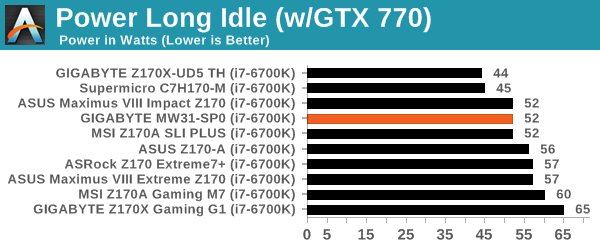
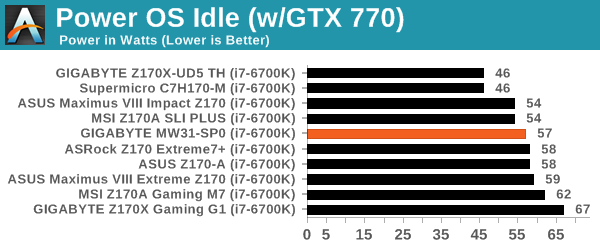
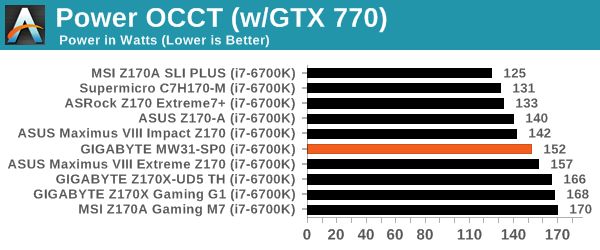
Idle power consumption on the MW31-SP0 was very mid-pack. The idle-to-load power delta with our base i7-6700K CPU was around 100W, which is high compared to a lot of boards we’ve tested.
Non-UEFI POST Time
Different motherboards have different POST sequences before an operating system is initialized. A lot of this is dependent on the board itself, and POST boot time is determined by the controllers on board (and the sequence of how those extras are organized). As part of our testing, we look at the POST Boot Time using a stopwatch. This is the time from pressing the ON button on the computer to when Windows 7 starts loading. (We discount Windows loading as it is highly variable given Windows specific features.)
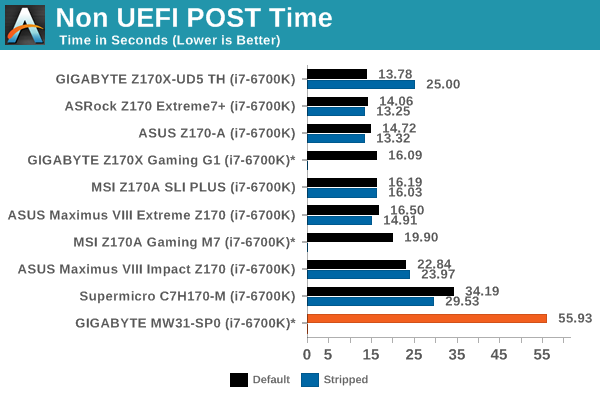
Server/workstation motherboards are not famed for their expediency in POST times, with little effort to improve the time as these systems might not be switched on/off for months at a time. This is why we see the POST time of around a minute for the MW31-SP0. Attempting to strip this to lowest possible POST time was fruitless, causing the system to either fail to boot or take over twice as long.
Rightmark Audio Analyzer 6.2.5
Rightmark:AA indicates how well the sound system is built and isolated from electrical interference (either internally or externally). For this test we connect the Line Out to the Line In using a short six inch 3.5mm to 3.5mm high-quality jack, turn the OS speaker volume to 100%, and run the Rightmark default test suite at 192 kHz, 24-bit. The OS is tuned to 192 kHz/24-bit input and output, and the Line-In volume is adjusted until we have the best RMAA value in the mini-pretest. We look specifically at the Dynamic Range of the audio codec used on board, as well as the Total Harmonic Distortion + Noise.
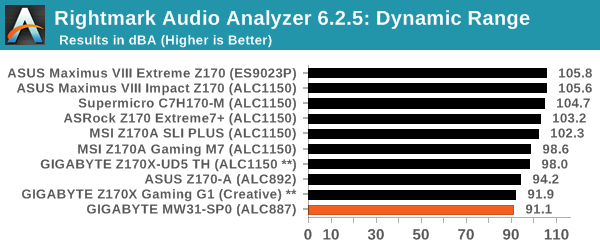

The onboard ALC887 codec is one of the cheapest 7.1 codecs that Realtek offer to motherboard manufacturers, and the price difference to an ALC892 or ALC898 is almost minuscule I wonder why GBT didn’t just go with the slightly higher specification part. Again, one could argue that the sorts of systems that this unit would go into might not ever use audio, and for workstation/office use there only needs to be enough audio to cover the basics.
USB Backup
For this benchmark, we transfer a set size of files from the SSD to the USB drive using DiskBench, which monitors the time taken to transfer. The files transferred are a 1.52 GB set of 2867 files across 320 folders – 95% of these files are small typical website files, and the rest (90% of the size) are small 30 second HD videos. In an update to pre-Z87 testing, we also run MaxCPU to load up one of the threads during the test which improves general performance up to 15% by causing all the internal pathways to run at full speed.
Due to the introduction of USB 3.1, as of June 2015 we are adjusting our test to use a dual mSATA USB 3.1 Type-C device which should be capable of saturating both USB 3.0 and USB 3.1 connections. We still use the same data set as before, but now use the new device. Results are shown as seconds taken to complete the data transfer.
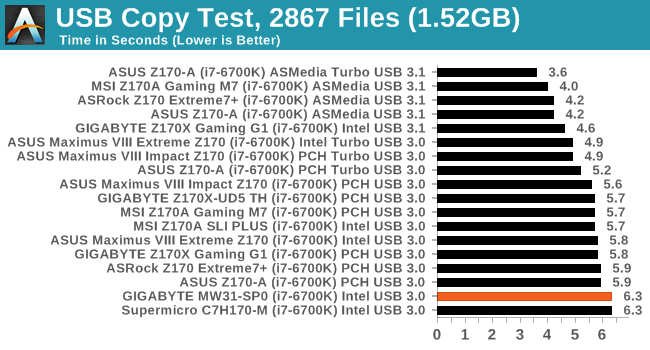
With no USB 3.1 here, we tested the USB 3.0 rear ports with our method. Similar to the Supermicro motherboard we tested, 6.3 seconds seems to be the low-performance metric which the MW31-SP0 matched.
DPC Latency
Deferred Procedure Call latency is a way in which Windows handles interrupt servicing. In order to wait for a processor to acknowledge the request, the system will queue all interrupt requests by priority. Critical interrupts will be handled as soon as possible, whereas lesser priority requests such as audio will be further down the line. If the audio device requires data, it will have to wait until the request is processed before the buffer is filled.
If the device drivers of higher priority components in a system are poorly implemented, this can cause delays in request scheduling and process time. This can lead to an empty audio buffer and characteristic audible pauses, pops and clicks. The DPC latency checker measures how much time is taken processing DPCs from driver invocation. The lower the value will result in better audio transfer at smaller buffer sizes. Results are measured in microseconds.

Historic experience would suggest that DPC Latency on server motherboards, like POST time, seems to be a relative afterthought. It doesn’t help that the newer Skylake platforms seem to require firmware and hardware optimization to get the best result, so we often see server motherboards not do well. At 264 microseconds, the MW31-SP0 joins that crowd.










28 Comments
View All Comments
Samus - Friday, April 22, 2016 - link
C232 didn't support vPro? Wow, talk about lack of foresight by Intel...they've been trying to push that as a corporate platform basically since Sandybridge and it wasn't even supported on their server platform?SFNR1 - Friday, April 22, 2016 - link
HP uses iLO in their E3 and Intel has the RMM4 for that.Samus - Friday, April 22, 2016 - link
The problem with iLO is all the entry level servers (non-E5) have iLO light which is kind of a management joke. Most of the remote management tools require iLO advanced which can be purchased as a license for some servers but not the ML110 because the eprom isn't large enough for the software. Even then, and this is hard for me to admit because in an HP guy, Dell's iDRAC is all around better, and free, like vPro. I'm just surprised vPro was never available on C232. Generally I use remoteKVM for management so this is all moot unless I actually need to hard power off equipment remotely and since I don't manage rack servers across the country that has never come up. Only once in my career have I had to jump in the car and drive somewhere to power a server back on because I accidentally shut it down lol.rtho782 - Friday, April 22, 2016 - link
I'd like to see a comparison of SLI performance between this, with the PLX switch, and other boards that split x8/x8.I know this has been done before but nothing with modern CPUs etc.
Vidmo - Friday, April 22, 2016 - link
You should also take a look at the Supermicro X11SAT-F as its a much better board than this one or even the Gigabyte X170-Extreme ECC.http://www.supermicro.com/products/motherboard/Xeo...
snakyjake - Sunday, April 24, 2016 - link
Will using software RAID with the dual SATA controllers be an advantage, disadvantage, or no affect?milkod2001 - Monday, April 25, 2016 - link
Are there any mini atx server boards with build in 14nm Atoms/Celerons/Pentium, ECC support for NAS units out there?atlantico - Friday, April 29, 2016 - link
Gigabyte, always the last on my list for components. Ugly mobos, terribad BIOS and "ATi CrossfireX support" printed on the mobo. Why not the 3DFX SLI? Dumb and ultimately 3rd rate Gigabyte.The sad thing is that Gigabyte isn't all that much cheaper than others, except in quality.